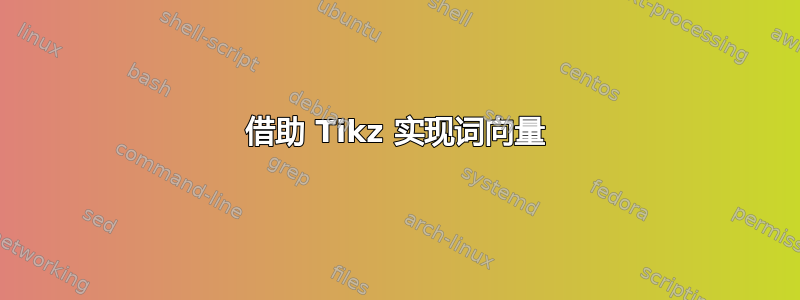
答案1
和tikz:
\documentclass[tikz, margin=3mm]{standalone}
\usetikzlibrary{chains, positioning}
\begin{document}
\begin{tikzpicture}[
node distance = 0mm and 5mm,
start chain = going below,
box/.style = {draw, minimum width=12mm, minimum height=6mm,
inner sep=0pt, outer sep=0pt,
on chain}
]
\node (a) [box,pin=left:Royalty] {};
\node[box,pin=left:Masculinity] {};
\node[box,pin=left:Femininity] {};
\node[box,pin=left:Age,
label=below:$\vdots$] {};
%
\node (b) [box,right=of a,label=:King] {0.99};
\node[box] {0.99};
\node[box] {0.05};
\node[box,label=below:$\vdots$] {0.7};
%
\node (c) [box,right=of b,label=:???] {0.99};
\node[box] {0.99};
\node[box] {0.93};
\node[box,label=below:$\vdots$] {0.7};
%
\node (d) [box,right=of c,label=:Women] {0.99};
\node[box] {0.99};
\node[box] {0.05};
\node[box,label=below:$\vdots$] {0.7};
%
\node[box,right=of d,label=:Princess] {0.98};
\node[box] {0.02};
\node[box] {0.94};
\node[box,label=below:$\vdots$] {0.1};
\end{tikzpicture}
\end{document}
你需要自己完成图像,因为我看不懂你的文字。正如所说成本加运费,tikz 可能对您的图像来说有点过度了。
代码稍微高级一些,所以我鼓励你阅读tikz 和 pgf 手册,至少第 3 部分:TikZ 不是一个绘画程序
编辑:谢谢亨利·孟克您的笔迹已被破译并包含在上面的图像和代码中。这些数字仍未得到验证,这个我留给您了。(作为练习,它们在代码中)。
答案2
我认为使用矩阵比 Zarko 的链式解决方案更容易一些。
\documentclass{article}
\pagestyle{empty}
\usepackage{tikz}
\usetikzlibrary{matrix}
\begin{document}
\begin{tikzpicture}
\matrix[
matrix of math nodes,
nodes in empty cells,
column sep=1em,
nodes={
draw,
anchor=south,
minimum width=3em,
minimum height=5ex
}] (m) {
& 0.99 & 0.99 & 0.02 & 0.98 \\
& 0.99 & 0.05 & 0.01 & 0.02 \\
& 0.05 & 0.93 & 0.999 & 0.94 \\
& 0.7 & 0.6 & 0.5 & 0.1 \\
& \vdots & \vdots & \vdots & \vdots \\
};
\begin{scope}[every node/.style={green!75!black,above=4ex,anchor=base}]
\node at (m-1-2) {King};
\node at (m-1-3) {Queen};
\node at (m-1-4) {Woman};
\node at (m-1-5) {Princess};
\end{scope}
\begin{scope}[every node/.style=blue!75!white]
\node[pin={left:Royalty}] at (m-1-1.west) {};
\node[pin={left:Masculinity}] at (m-2-1.west) {};
\node[pin={left:Femininity}] at (m-3-1.west) {};
\node[pin={left:Age}] at (m-4-1.west) {};
\end{scope}
\end{tikzpicture}
\end{document}
我们还可以制作一个底部没有边框的新节点形状,我称之为house。
\documentclass{article}
\usepackage{tikz}
\usetikzlibrary{matrix}
\makeatletter
\pgfdeclareshape{house}
{
\inheritsavedanchors[from=rectangle] % this is nearly a rectangle
\inheritanchorborder[from=rectangle]
\inheritanchor[from=rectangle]{north}
\inheritanchor[from=rectangle]{north west}
\inheritanchor[from=rectangle]{north east}
\inheritanchor[from=rectangle]{center}
\inheritanchor[from=rectangle]{west}
\inheritanchor[from=rectangle]{east}
\inheritanchor[from=rectangle]{mid}
\inheritanchor[from=rectangle]{mid west}
\inheritanchor[from=rectangle]{mid east}
\inheritanchor[from=rectangle]{base}
\inheritanchor[from=rectangle]{base west}
\inheritanchor[from=rectangle]{base east}
\inheritanchor[from=rectangle]{south}
\inheritanchor[from=rectangle]{south west}
\inheritanchor[from=rectangle]{south east}
\foregroundpath{
% store lower right in xa/ya and upper right in xb/yb
\southwest \pgf@xa=\pgf@x \pgf@ya=\pgf@y
\northeast \pgf@xb=\pgf@x \pgf@yb=\pgf@y
\pgfpathmoveto{\pgfqpoint{\pgf@xa}{\pgf@ya}}
\pgfpathlineto{\pgfqpoint{\pgf@xa}{\pgf@yb}}
\pgfpathlineto{\pgfqpoint{\pgf@xb}{\pgf@yb}}
\pgfpathlineto{\pgfqpoint{\pgf@xb}{\pgf@ya}}
\pgfsetarrowsstart{}
\pgfsetarrowsend{}
}
}
\makeatother
\begin{document}
\begin{tikzpicture}
\matrix[
matrix of math nodes,
nodes in empty cells,
column sep=1em,
nodes={
draw,
house,
anchor=south,
minimum width=3em,
minimum height=5ex
}] (m) {
& 0.99 & 0.99 & 0.02 & 0.98 \\
& 0.99 & 0.05 & 0.01 & 0.02 \\
& 0.05 & 0.93 & 0.999 & 0.94 \\
& 0.7 & 0.6 & 0.5 & 0.1 \\
& \vdots & \vdots & \vdots & \vdots \\
};
\begin{scope}[every node/.style={green!75!black,above=4ex,anchor=base}]
\node at (m-1-2) {King};
\node at (m-1-3) {Queen};
\node at (m-1-4) {Woman};
\node at (m-1-5) {Princess};
\end{scope}
\begin{scope}[every node/.style=blue!75!white]
\node[pin={left:Royalty}] at (m-1-1.west) {};
\node[pin={left:Masculinity}] at (m-2-1.west) {};
\node[pin={left:Femininity}] at (m-3-1.west) {};
\node[pin={left:Age}] at (m-4-1.west) {};
\node[pin={[pin edge={draw=none}]left:$\cdots$}] at (m-5-1.west) {};
\end{scope}
\end{tikzpicture}
\end{document}
答案3
在常规tabular环境下
\documentclass{article}
\usepackage{xcolor}
\usepackage{tabularx}
\newcolumntype{P}[1]{>{\centering\arraybackslash}m{#1}}
\renewcommand{\tabularxcolumn}[1]{>{\raggedleft\arraybackslash}m{#1}}
\newcommand\T{\rule{0pt}{6ex}}
\begin{document}
\begin{table}[h]
\begin{tabularx}{\linewidth}{@{}l P{6ex}*{9}{c}@{}}
\multicolumn{1}{r}{} & & & \multicolumn{1}{>{\hsize=0.18\hsize}X}{\color{green} King\hfill} & & \multicolumn{1}{>{\hsize=0.18\hsize}X}{\color{green} Queen} & & \multicolumn{1}{l}{\color{green} Woman} & & \multicolumn{1}{l}{\color{green} Princess} \\[2ex] \cline{2-2} \cline{4-4} \cline{6-6} \cline{8-8} \cline{10-10}
\multicolumn{1}{r|}{\color{blue}Royalty ---} & \multicolumn{1}{c|}{} & \multicolumn{1}{c|}{} & \multicolumn{1}{c|}{$0.99$} & \multicolumn{1}{c|}{} & \multicolumn{1}{c|}{$0.99$} & \multicolumn{1}{c|}{} & \multicolumn{1}{c|}{$0.02$} & \multicolumn{1}{c|}{} & \multicolumn{1}{c|}{$0.98$} \T\\[3ex] \cline{2-2} \cline{4-4} \cline{6-6} \cline{8-8} \cline{10-10}
\multicolumn{1}{r|}{\color{blue}Masculinity ---} & \multicolumn{1}{c|}{} & \multicolumn{1}{c|}{} & \multicolumn{1}{c|}{$0.99$} & \multicolumn{1}{c|}{} & \multicolumn{1}{c|}{$0.05$} & \multicolumn{1}{c|}{} & \multicolumn{1}{c|}{$0.01$} & \multicolumn{1}{c|}{} & \multicolumn{1}{c|}{$0.02$} \T\\[3ex] \cline{2-2} \cline{4-4} \cline{6-6} \cline{8-8} \cline{10-10}
\multicolumn{1}{r|}{\color{blue}Feminity ---} & \multicolumn{1}{c|}{} & \multicolumn{1}{c|}{} & \multicolumn{1}{c|}{$0.05$} & \multicolumn{1}{c|}{} & \multicolumn{1}{c|}{$0.93$} & \multicolumn{1}{c|}{} & \multicolumn{1}{c|}{$0.999$} & \multicolumn{1}{c|}{} & \multicolumn{1}{c|}{$0.94$} \T\\[3ex] \cline{2-2} \cline{4-4} \cline{6-6} \cline{8-8} \cline{10-10}
\multicolumn{1}{r|}{\color{blue}Age ---} & \multicolumn{1}{c|}{} & \multicolumn{1}{c|}{} & \multicolumn{1}{c|}{$0.07$} & \multicolumn{1}{c|}{} & \multicolumn{1}{c|}{$0.6$} & \multicolumn{1}{c|}{} & \multicolumn{1}{c|}{$0.5$} & \multicolumn{1}{c|}{} & \multicolumn{1}{c|}{$0.1$} \T\\[3ex] \cline{2-2} \cline{4-4} \cline{6-6} \cline{8-8} \cline{10-10}
\multicolumn{1}{c|}{$\color{blue}\cdots$} & \multicolumn{1}{c|}{$\vdots$} & \multicolumn{1}{c|}{} & \multicolumn{1}{c|}{$\vdots$} & \multicolumn{1}{c|}{} & \multicolumn{1}{c|}{$\vdots$} & \multicolumn{1}{c|}{} & \multicolumn{1}{c|}{$\vdots$} & \multicolumn{1}{c|}{} & \multicolumn{1}{c|}{$\vdots$} \T
\end{tabularx}
\end{table}
\end{document}







